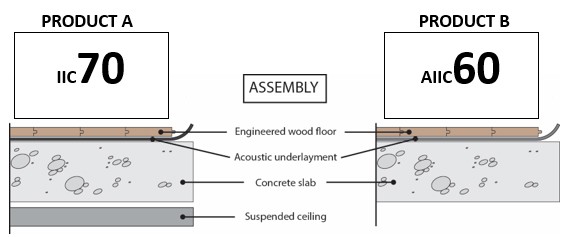The attractive power of high ratings in sound insulation

Tuesday, 23 October 2018
Developers, architects and builders are looking for acoustic products to meet National Building Code guidelines in new construction. Property managers and board of directors in condominiums are looking to solve or prevent problems in existing buildings/renovations. Owners are simply trying to follow their condo regulation chart when renovating floors. They do that by looking at soundproofing ratings, which can often become a nightmare. How to make the right choice: by opting for the highest numbers on the market?
An acoustic membrane can offer several ratings: true or false?
Some acoustic membranes available on the market advertise very high acoustic ratings. Some will truly deliver decent acoustic efficiency in your building although others will rate below your expectations and even below the National Building Code recommendation. The same product can perform at AIIC 70, 60 or even 42. Here's why the acoustic performance of a membrane can vary significantly.
Factors that influence sound insulation
The building structure, quality of construction and installation methods, type of flooring to be installed overtop, room volume, etc. are all elements that play a significant role in the acoustic efficiency of the building. The membrane does not do all the work of attenuating noise, it is actually a small contributor to the overall rating of an assembly.
High rating displayed: myth or reality?
Each building is different. No acoustical barrier on the market place can arbitrarily claim to provide every home with the same sound absorbance. What they are claiming though is that under very specific test situations the product and substrate, when tested together, achieved certain IIC levels. If in doubt ask, how was this product tested when it achieved an IIC of 70. Only by knowing the test parameters can you understand what it is that you are actually buying or specifying and make sure this is the proper solution to respect your requirements.
Example of comparaison

Analysis & facts
- Product A is tested in a controlled lab, without windows, furniture and all materials are installed in perfect conditions. A suspended ceiling, including acoustic insulation, wires and gypsum board ceiling was added to the assembly.
- Product B is tested in a real-life environment and takes the flanking into consideration. There is no suspended ceiling.
- Most condominiums made of concrete don’t have a suspended ceiling (they have a gypsum ceiling finish or visible concrete).
- A suspended ceiling can add up to 14 points more to the performance.
- Buyers think that product A is better and will meet their board’s requirements
- Boards of directors and property managers often require to reach IIC 70+ for the replacement of floor covering, without knowing the efficiency of their structure and its potential.
- The available space/thickness between baseboards and the structure is neglected. For instance, some products or combination of products can really bring your ceramic tiles to AIIC 70 but with the consequence of cutting doors, baseboards and even cabinets. This is something that usually can’t be done.
Conclusion
When purchasing an acoustical membrane, Product "A" appears to be more efficient than Product "B". But after comparing the results, Product "B" is actually more efficient and more reliable to your building.